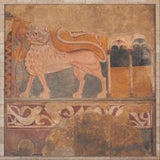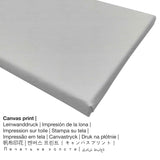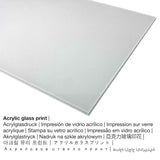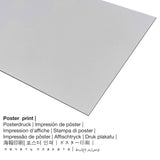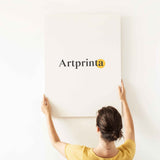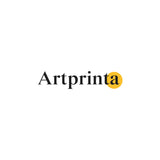Nke a masterpiece Lion onye na-ese ihe mere ya Unknown. The original measures the size: Overall: 10 ft, 11 in x 11 ft, (332,7 x 335,3 cm) Overall (top panel): 83 x 132 in (210,8 x 335,3 cm) Overall (lower panel): 48 x 132 in (121,9 x 335,3 cm). Fresco, mounted on canvas was applied by the painter as the technique for the painting. Moveover, this artwork is part of the digital art collection of Museumlọ ihe ngosi nka nke Obodo, nke bụ otu n'ime ụlọ ngosi ihe ngosi nka kachasị ukwuu na nke kachasị mma n'ụwa, nke gụnyere ihe karịrị nde abụọ ọrụ nka na-agbatị puku afọ ise nke ọdịbendị ụwa, site na prehistory ruo ugbu a na site n'akụkụ ọ bụla nke ụwa. ngalaba ọha artwork is provided with courtesy of The Metropolitan Museum of Art, New York, The Cloisters Collection, 1931. Furthermore, the work of art has the creditline: Nchịkọta Cloisters, 1931. N'elu nke ahụ, nhazi a na-abanye square usoro ma nwee oke akụkụ nke 1: 1, nke pụtara na ogologo ya na obosara.
Nye iwu ihe kacha amasị gị
Nchịkọta nhọrọ ngwaahịa na-enye gị ohere ịhọrọ nha na ihe ị họọrọ. Ka ị kwekọọ n'ihe ị chọrọ nke ọma, ị nwere ike họrọ n'ime nhọrọ nhazi ngwaahịa ndị a:
- Mbipụta nke aluminom: Aluminium Dibond prints are prints on metal with an impressive depth - for a modern look and a non-reflective surface. The Aluminium Dibond Print is your best start to art replicas with aluminum. For the Direct Print On Aluminum Dibond, we print the artpiece right onto the aluminium white-primed surface. The bright and white parts of the original artwork shine with a silky gloss but without glow. The colors are bright and vivid, the fine details of the print are crisp, and there’s a matte look you can literally feel.
- Mbipụta kwaaji: A canvas direct print is a printed canvas stretched on a wood frame. Your printed canvas of this masterpiece will allow you to transform your fine art print into a large collection piece like you know from art galleries. The advantage of canvas prints is that they are relatively low in weight, which implies that it is quite simple to hang the Canvas print without additional wall-mounts. A canvas print is suitable for all kinds of walls in your house.
- Akwụkwọ mmado na ihe kwaaji: Our poster print is a printed cotton canvas with a slightly roughened finish on the surface. Please bear in mind, that depending on the absolute size of the canvas poster print we add a white margin between 2-6cm around the print, which facilitates the framing with a custom frame.
- Mbipụta enyo acrylic: A glossy acrylic glass print, which is often referred to as a print on plexiglass, will turn the original artwork into great home décor and is a great alternative to canvas and aluminidum dibond fine art prints. Your favorite work of art is custom-made with the help of modern UV print machines. With an acrylic glass art print contrasts and also granular details will be identifiable due to the fine tonal gradation. Our plexiglass with real glass coating protects your selected fine art print against light and external influences for many years to come.
Nkwupụta iwu: We strive to describe the art products with as many details as possible and to demonstrate them visually. However, the tone of the print products and the imprint can vary somehwat from the presentation on the device's monitor. Depending on the settings of your screen and the nature of the surface, color pigments might not be printed as realisitcally as the digital version on this website. Because our fine art prints are processed and printed manually, there might as well be slight differences in the size and exact position of the motif.
Ozi ndabere edemede
| Nkewa ngwaahịa: | ọrụ mgbidi |
| Mmeputakwa: | dijitalụ mmeputakwa |
| Production usoro: | Mbipụta UV ozugbo (mbipụta dijitalụ) |
| Mmalite nke ngwaahịa a: | emere na Germany |
| Stockdị ngwaahịa: | mmepụta ihe na-achọ |
| A na-atụ aro iji ngwaahịa eme ihe: | ịchọ mma mgbidi, mkpokọta nka (mmeputakwa) |
| Nhazi onyonyo: | usoro square |
| Oke akụkụ: | 1: 1 |
| Nkọwa nke oke akụkụ: | ogologo ya na obosara |
| Ụdị ihe dị iche iche dị: | Mpempe iko acrylic (nke nwere ezigbo mkpuchi iko), mbipụta ọla (aluminium dibond), mbipụta akwụkwọ mmado (akwụkwọ kwaaji), mbipụta kwaaji. |
| Nhọrọ nha nha mbipụta kanvas (akwa akwa na etiti ihe ndọtị): | 20x20cm - 8x8 ", 30x30cm - 12x12", 50x50cm - 20x20", 70x70cm - 28x28", 100x100cm - 39x39", 150x150cm - 59x59", 180-x180cm |
| Mpempe iko acrylic (nwere ezigbo mkpuchi iko) nha: | 20x20cm - 8x8 ", 30x30cm - 12x12", 50x50cm - 20x20", 70x70cm - 28x28", 100x100cm - 39x39", 150x150cm - 59x59", 180-x180cm |
| Nhọrọ nha nke akwụkwọ mmado (akwụkwọ kwaaji): | 30x30cm - 12x12", 50x50cm - 20x20", 70x70cm - 28x28", 100x100cm - 39x39" |
| Ụdị mbipụta Dibond (ihe alumnium) dị iche iche: | 20x20cm - 8x8", 30x30cm - 12x12", 50x50cm - 20x20", 70x70cm - 28x28", 100x100cm - 39x39" |
| Igwe onyonyo: | adịghị |
Nkọwa ọrụ nka
| Akụkụ nka: | "Ọdụm" |
| nhazi ọkwa: | sere |
| Okwu mkpokọta: | nka ochie |
| Nhazi oge: | 13th narị afọ |
| Emepụtara na: | 1200 |
| Ogologo afọ nka nka: | 820 afọ |
| Agba na: | fresco, nke etinyere na kwaaji |
| Akụkụ izizi (ọrụ nka): | Overall: 10 ft, 11 in x 11 ft, (332,7 x 335,3 cm) Overall (top panel): 83 x 132 in (210,8 x 335,3 cm) Overall (lower panel): 48 x 132 in (121,9 x 335,3 cm) |
| Egosiputara na: | Museumlọ ihe ngosi nka nke Obodo |
| Ebe ngosi nka: | New York City, New York, Njikota Obodo Amerika |
| website: | www.metmuseum.org |
| License: | ngalaba ọha |
| Site n'aka: | Ụlọ ihe ngosi nka nke Metropolitan, New York, mkpokọta Cloisters, 1931 |
| kreditline ọrụ nka: | Nchịkọta Cloisters, 1931 |
metadata omenka ahaziri ahazi
| Aha onye nka: | Unknown |
| Ọrụ onye na-ese ihe: | onye na-ese ihe |
| nhazi ọkwa: | nna ukwu ochie |
© Nwebiisinka - ikike ọgụgụ isi nke - www.artprinta.com (Artprinta)
Nkọwapụta nka sitere na ihe ngosi nka (© Nwebiisinka - nke Ụlọ ihe ngosi nka nke Obodo ukwu - www.metmuseum.org)
By portraying this lion with his muscles taut, his fur standing on end, and his gaze intense, the artist conveyed the power of this snarling big cat. Medieval beasts, whether real or imaginary, were often imbued with symbolic meaning, as they are in animal fables today. It is not always possible, however, to reconstruct their specific intention in a given monument, and such beasts could be for “aesthetic delight,” as one thirteenth-century archbishop commented. The monastery from which this fresco comes was abandoned in 1841.

